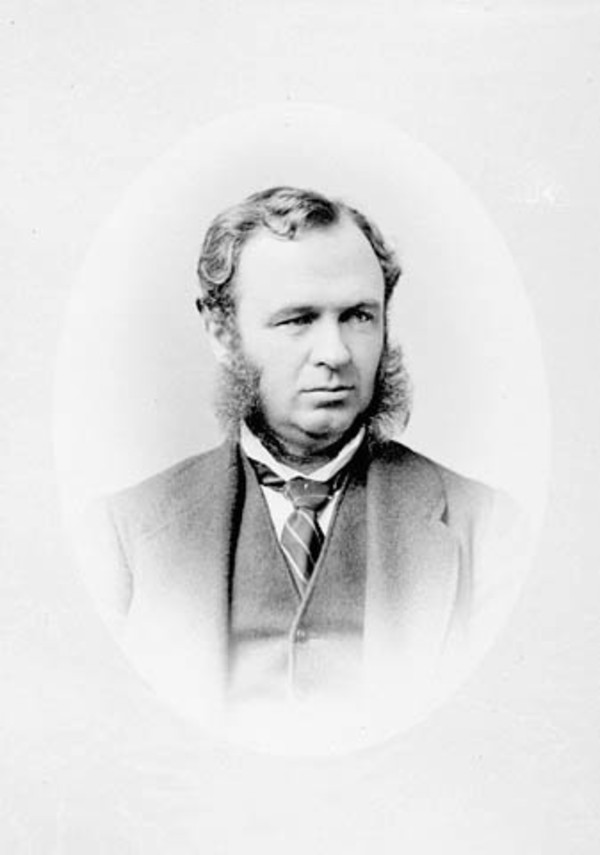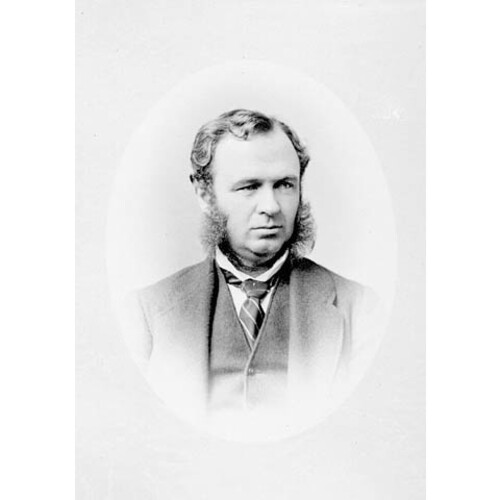PARDEE, TIMOTHY BLAIR, lawyer and politician; b. 11 Dec. 1830 in Grenville County, Upper Canada, son of Aaron B. Pardee and Jane Elliott; m. Emma Kirby Forsyth of Lambton County, and they had six children; d. 21 July 1889 in Sarnia, Ont.
After leaving school Timothy Blair Pardee articled briefly in the Brockville law office of William Buell Richards, later chief justice of Canada. But Pardee grew restless and abandoned law and the settled life of a small provincial town for the excitement of the California gold-rush in 1849. He passed two eventful but fruitless years in California before gold fever carried him, along with so many others, to Australia. After five years in the gold-fields there, he returned to Canada – without a fortune – to resume his studies in the office of Joshua Adams of Sarnia. He was called to the bar in 1861. Soon afterwards he was appointed crown attorney for Lambton County, a position he gave up in 1867 to run for political office. He was to be elected a bencher of the Law Society of Upper Canada in 1871 and named a qc in 1876.
A hearty, well-liked man about town, with a wealth of stories from his adventures, Pardee made an immediate success of politics. Running in the 1867 Ontario general election as a Reformer in Lambton he defeated the former warden of the county, Robert Rae, by a two-to-one margin. He was acclaimed in 1871 and again in the by-election of 1872 necessitated by his elevation to the cabinet. After redistribution in 1874 he held Lambton West for the Reform (or Liberal) party in four consecutive general elections, 1875, 1879, 1883, and 1886.
Premier Oliver Mowat* chose Pardee on 25 Oct. 1872 as provincial secretary in his first administration. A little more than a year later (4 Dec. 1873), upon the resignation and removal to Ottawa of Richard William Scott*, Pardee replaced him as commissioner of crown lands, a post he would hold for the next 16 years, longer than any other incumbent. The appointment of the popular but inexperienced western Ontario lawyer to a cabinet position usually reserved for an eastern Ontario lumberman surprised many people at the time. But Mowat, intent upon breaking up the cozy relationship that had developed between the department and the lumbermen, wanted someone with Pardee’s ability and detachment to end the timber sale scandals and clean up the administrative chaos left behind by Scott. During his long term as commissioner Pardee did much, as did his long-time deputy, Thomas Hall Johnson (assistant commissioner of crown lands from 1869 to 1887), to regularize the administration of the province’s natural resources and to restore the reputation of the department.
Crown lands was a demanding portfolio whose jurisdiction included surveys, colonization roads, mines, the administration of school lands, homesteads, and free grants. By far the most important function of the department, and its greatest revenue producer, was the regulation of logging in the provincial forests. The department held timber auctions whenever market conditions warranted, issued annual cutting licences, maintained a small field staff to oversee woods operations, and collected bonus, stumpage, and ground-rent payments from the lumbermen. Between 1867 and 1899 the woods and forests branch of the Crown Lands Department accounted for 28 per cent of the total provincial revenue, a proportion exceeded only by the federal subsidy.
After a providently timed sale of 5,031 square miles of timber by Scott just before the election in 1872 there was no need to put more timber on the market immediately, aside from small amounts of burnt timber and railway ties. Pardee, in fact, disposed of comparatively little timber during his long tenure of office, probably on account of the generally depressed condition of the trade. In 16 years he authorized only four auctions, in 1877, 1881, 1885, and 1887 for 375, 1,379, 1,012, and 459 square miles respectively – less than Scott had disposed of in 1872 alone. His last sale, for which timber dues were raised from 75¢ to $1 per 1,000 board foot of lumber and ground-rent was raised from $2 to $3 per square mile, occasioned a notable confrontation between the outraged lumbermen of the province and the government. On 14 Dec. 1887, the day before the auction, a deputation of lumbermen met with Pardee and Mowat in the parliamentary library. Mowat refused to back down on the new price schedules, and the lumbermen, thinking matters over later that evening, announced that they would not enter bids on the timber being offered for sale the next day. But come the time of the auction the natural avarice and mutual suspicions of the lumbermen undermined the boycott and the receipts from the auction were record bonus payments over and above ground-rent and dues to the provincial treasury.
Pardee was probably best known outside lumber circles as the minister responsible for Ontario’s first forest protection legislation, an Act to Prevent the Forests from Destruction by Fire, passed in 1878. Though it relied upon the good will of lumbermen, this act focused public attention upon the menace of forest fire for the first time.
Pardee was a favourite in the legislature but, although he was a good stump orator, he seldom contributed to debates. He made his mark mainly in the lobbies and in the council chamber. It was said of him that he played the role of devil’s advocate in the Mowat cabinet, exposing the weaknesses in potential appointments, policies, and government bills. In his last years his health deteriorated and he did not attend the legislature to defend his estimates during his last two sessions. When Mowat finally accepted his resignation on 25 Jan. 1889 expressions of regret came from both sides of the house. After his death Pardee was paid an immense tribute as well, in 1893, when his portrait was placed among those of seven other worthies of Ontario history on the western façade of the front portal of the new parliament buildings at Queen’s Park.
AO, Clarke (Charles) papers; MU 20–28; MU 1745, 14, 15 Dec. 1887; MU 2119, 1878; MU 2194; RG 1, especially A-I-8, 3; A-II-2, 6–8; A-VII, 19–22; E-6, 2–3; E-12, 5–6. PAC, MG 27, II, D14, 3–6; MG 28, III26, 704. Ont., Legislature, Sessional papers, 1871–90 (reports of the commissioners of crown lands). Aubrey White, Forest fires and fire ranging: report . . . addressed to commissioner of crown lands (Toronto, 1886). Globe, 31 Jan. 1878; 26 Jan., 22 July 1889. Centennial edition of a history of the electoral districts, legislatures and ministries of the province of Ontario, 1867–1967, comp. Roderick Lewis (Toronto, [1969]). CPC, 1889. Cyclopædia of Canadian biog. (Rose, 1886). Dent, Canadian portrait gallery, IV. A statistical history of all the electoral districts of the province of Ontario since 1867, comp. Roderick Lewis (Toronto, n.d.). C. R. W. Biggar, Sir Oliver Mowat . . . a biographical sketch (2v., Toronto, 1905). “A history of crown timber regulations from the date of the French occupation to the year 1899,” Ont., Clerk of Forestry, Annual report (Toronto), 1899 (repr. 1907; 1957). R. S. Lambert and Paul Pross, Renewing nature’s wealth; a centennial history of the public management of lands, forests & wildlife in Ontario, 1763–1967 ([Toronto], 1967). H. V. Nelles, The politics of development: forests, mines & hydro-electric power in Ontario, 1849-1941 (Toronto, 1974). Frank Yeigh, Ontario’s parliament buildings; or, a century of legislation, 1792–1892: a historical sketch (Toronto, 1893).
Cite This Article
H. V. Nelles, “PARDEE, TIMOTHY BLAIR,” in Dictionary of Canadian Biography, vol. 11, University of Toronto/Université Laval, 2003–, accessed November 23, 2024, https://www.biographi.ca/en/bio/pardee_timothy_blair_11E.html.
The citation above shows the format for footnotes and endnotes according to the Chicago manual of style (16th edition). Information to be used in other citation formats:
| Permalink: | https://www.biographi.ca/en/bio/pardee_timothy_blair_11E.html |
| Author of Article: | H. V. Nelles |
| Title of Article: | PARDEE, TIMOTHY BLAIR |
| Publication Name: | Dictionary of Canadian Biography, vol. 11 |
| Publisher: | University of Toronto/Université Laval |
| Year of publication: | 1982 |
| Year of revision: | 1982 |
| Access Date: | November 23, 2024 |




